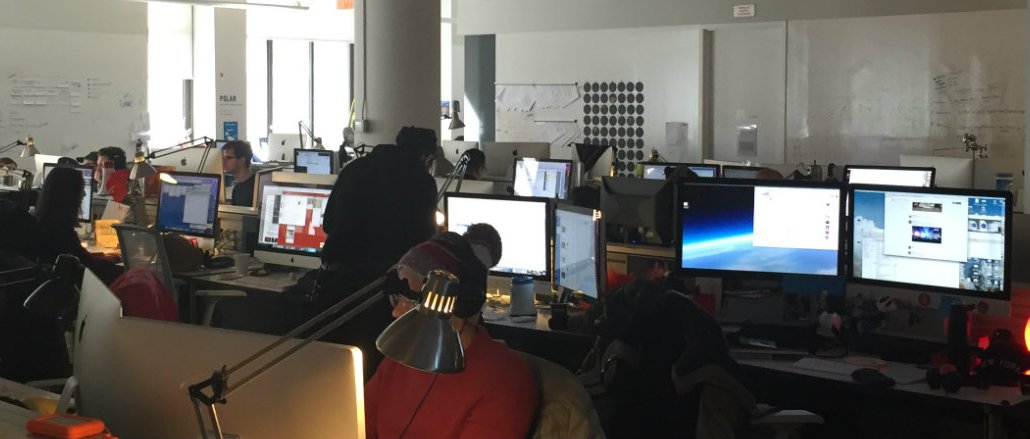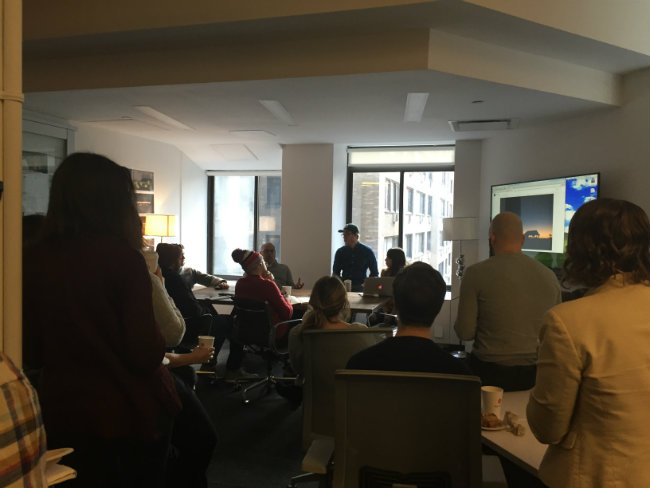Save 50% on a 3-month Digiday+ membership. Ends Dec 5.

When you walk into Great Big Story’s offices near New York City’s Union Square, the first thing you notice is the wall with seven flat-screen monitors. On display are all of the hallmarks of a socially distributed video network: There’s a running tally of YouTube stats, daily viewership trends, a live feed of CNN, and a tracker of the publisher’s social feeds.
“It’s the extension of our collective brains,” said Chris Berend, co-founder of Great Big Story, a CNN veteran of two and a half years. “The wall is where the work of our team manifests itself. They get to see their video on big and small screens and on silent and constant loop to see how it plays in different environments. They can see how it’s performing and what else is going on in the world.”
Great Big Story launched in October as an independent subsidiary of CNN. The news giant wants to mimic the success digital publishers like BuzzFeed and Vice have had with inspirational or edgy content on social platforms without being weighed down by the association with the parent brand, with its older-skewing audience. Its head of sales, David Spiegel, is even a BuzzFeed vet.
“Everybody gets compared to Vice and BuzzFeed because they’re the big digital-native companies,” Berend said. “We feel that there is a huge audience out there that neither of those brands are connecting with.”
Great Big Story wants to do substantive stories for “smart, curious” (and yes, millennial) viewers, he added. It’s also not doing hard news. So far, this has meant a lot of mini-profiles on weird or interesting people and places. Recent examples include videos about a prolific rock climber who just happens to be 14 years old and a CrossFit instructor and double amputee who can bench press 445 pounds and climb rope while in his wheel chair.
“It’s someone who has either aged out of or doesn’t necessarily identify with Vice — who’s not a 22-year-old white male. And it’s someone who may have totally eaten up the cotton candy of BuzzFeed but thinks there’s something more to life than that and actually enjoys consuming content that makes them think a little bit.”
Four months in, Great Big Story appears to be building an audience. According to the company, it has achieved 160 million video starts across its platforms, which include its website, mobile apps and Facebook and YouTube channels. Nine million uniques have visited the company’s site and mobile apps since launch, with the apps averaging more than five minutes in time spent per user per week. On Facebook, GBS has more than 2 million fans; on YouTube, it has 143,000 subscribers. The average age of its audience is 25 — half that of CNN’s on TV.
Ad position: web_incontent_pos1
The editorial process
The makeup of Great Big Story’s 30-person staff is telling: one-third consists of video producers, one-third is sales — and 20 percent are in audience development, with plans to grow overall size to 40 by the end of the year. Mornings begin with an all-staff editorial meeting led by executive producer Courtney Coupe and head of audience intelligence Khalil Jetha. Pitches get posted to Trello and are reviewed daily by Coupe, Jetha, director of content and programming Matt Drake and two senior producers during a daily pitch review meeting.

GBS produces three to five videos a day — typically in the two- to four-minute range, though the company plans to do more long-form content in the future. While distributing across different platforms, the company isn’t tailoring videos to those platforms.
“Every publisher has a finite amount of resources, and I don’t know the answer for us in the long term is to be a chameleon,” Berend said.
Revenue opportunity
On the revenue side, GBS is exclusively focused on selling branded short films and series. The first two clients are General Electric and Hewlett Packard Enterprise.
Ad position: web_incontent_pos2
GBS has a framework under which it approaches branded content. For instance, Hewlett Packard Enterprise funded an eight-part video series, “The Dreamers,” that’s scheduled to start rolling out Feb. 17. In two of the videos, Hewlett Packard Enterprise technology is the star. The other six are purely editorial, profiling people who are using technology to advance various causes. The Hewlett Packard Enterprise brand shows up in the editorial videos, but it’s subtle; in one case, it’s used as a data source.
Berend said that 60 percent of his time is spent working with Spiegel to talk to advertisers and come up with ideas for branded content. The company expects to release about a dozen branded series in the next six months, he added.
GBS has the trappings of a startup, albeit one with Turner benefits. According to Spiegel, GBS will sell packages that allow advertisers to buy an entire commercial pod on a Turner-owned linear network or streaming app to air one of its branded videos. “Based on what the audience responded to the most on social, we can find where that audience exists across Turner,” he said. “It gives the customer something that’s not only hitting the social stratosphere, but getting it on to the big screen as well.”
Going beyond social
GBS isn’t looking to advertising alone for revenue. Most of GBS’s video audience is on Facebook and YouTube, but the company is eyeing other distribution platforms, too. Berend wouldn’t name specific platform partners but said GBS has been in talks with video streaming app providers about creating original content for them or licensing GBS’s existing work, pointing out that the revenue from such deals can be as big as branded content.
GBS content will also show up on video portals from AOL, Yahoo and Condé Nast in the coming months.
“Do I think this is a multibillion-dollar business? No, but we don’t need to be,” said Spiegel. “As you watch more and more companies go into this space, they tend to become a catch-all of everything because they’re chasing scale. We don’t have to go into breaking news because CNN already does it. We don’t have to do sports and entertainment because Turner’s already covering it. We might not be a fit for everybody, but we are a fit for a lot of people.”
More in Media

What publishers are wishing for this holiday season: End AI scraping and determine AI-powered audience value
Publishers want a fair, structured, regulated AI environment and they also want to define what the next decade of audience metrics looks like.

Digiday+ Research Subscription Index 2025: Subscription strategies from Bloomberg, The New York Times, Vox and others
Digiday’s third annual Subscription Index examines and measures publishers’ subscription strategies to identify common approaches and key tactics among Bloomberg, The New York Times, Vox and others.

From lawsuits to lobbying: How publishers are fighting AI
We may be closing out 2025, but publishers aren’t retreating from the battle of AI search — some are escalating it, and they expect the fight to stretch deep into 2026.
Ad position: web_bfu
